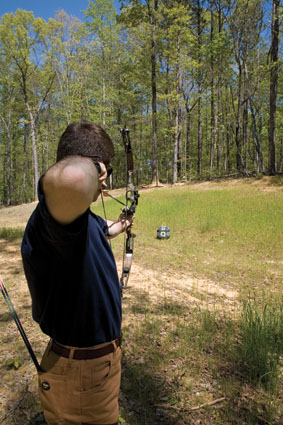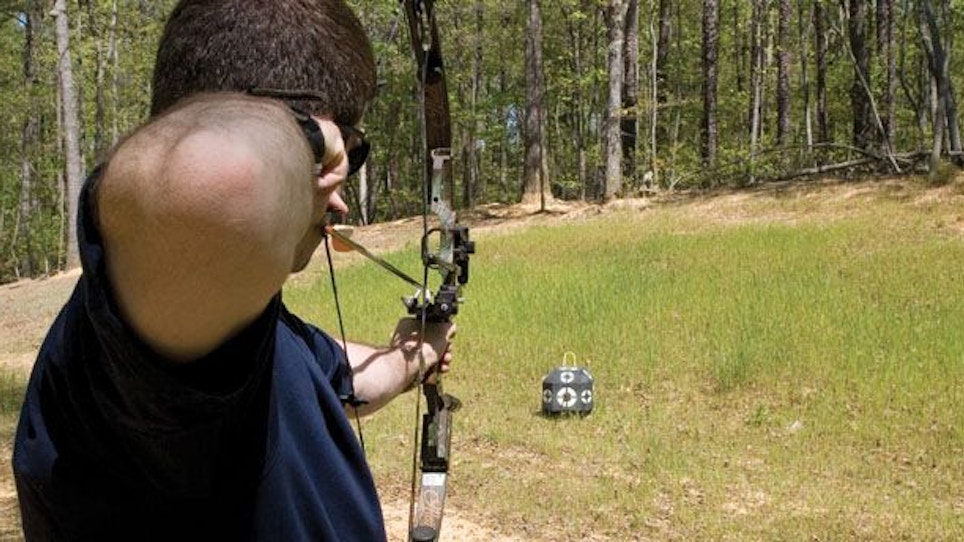 Match your practice sessions to actual hunting situations. A big game hunter doesn’t need to shoot quarter-size groups. What he needs to do is shoot groups the size of a vital zone under adverse shooting conditions.
Match your practice sessions to actual hunting situations. A big game hunter doesn’t need to shoot quarter-size groups. What he needs to do is shoot groups the size of a vital zone under adverse shooting conditions.
During practice sessions, vary your angles, distances, and shooting positions. Too many hunters shoot again and again from the same place in the same way. This gives them an exaggerated impression of their hunting accuracy. A whitetail’s not going to give you a couple of warm-up shots. You must be able to put that first arrow in there from odd angles and unknown distances. The best practice is to set up a course of targets at varying distances and uphill/downhill angles.
If you plan to hunt exclusively from treestands, it makes no sense to practice on the same level as your target. Shoot down a steep bank, from the roof of your garage, or, better yet, from an actual treestand. Practice in the clothes you’ll wear hunting. Practice both quick shooting and holding full draw as long as you can. Again, practice as if your first arrow is your only arrow.
As well as a realistic setting, you should use realistic targets. Most bowhunters benefit greatly from using lifelike targets of game animals. They help you pick and hit vital zones and practice visualization. An archery club range with a whole zoo of Styrofoam game animals is an ideal place for a bowhunter to practice. You might even set up your own course with treestands, ground blinds, and different types of animals.
The next best thing to lifelike targets is a target without a bullseye. This might be a couple of hay bales, a plain straw butt, or my favorite – sand dunes. (I seldom miss.) The worst thing to use is a target with a bullseye. Turn your target around, or paint the front a solid color. Then pick your own imaginary bullseye, as you’ll have to do when shooting at game.
While you practice, learn your effective range. Many bowhunters have a rude awakening when they shoot at life-size targets. Try it, to find your realistic shooting range, or else use this rule: If you can keep five of six arrows in a 9-inch circle (6-inch circle from a treestand), you’re within effective deer-shooting range. If not, wait for a closer shot.
If you use a compound bow, make yardage calculation a science. For the archer with a bow sight, shooting accuracy is proportional to accuracy in judging range. You can practice range estimation constantly while walking through the woods. Pick out a tree in your path, guess the yardage, and step it off. When you get there, pick out another tree and do it again. Training really can enhance your ability to judge distance. Note that changes in vegetation thickness and elevation will change your depth perception. This method is even better, of course, if you bring your bow along and do some stump-shooting.
Some bowhunters believe in electronic rangefinders. It is very difficult to take a reading on an animal that has entered bow range, but you can get the range of an object in the animal’s path and be ready to shoot when it gets there.
One technique few bowhunters practice is shooting at targets behind and just to one side of a tree. The obstruction can create a psychological block (which I don’t completely understand) that causes some archers to shoot toward the tree, others away from it. Test it to see how it affects your shooting – before the target behind that tree is your buck.
The Moment Of Truth
When taking your long-awaited shot, you must not only be in control; you must act correctly – do the right thing at the right time. Some hunters have a knack for making wise decisions in a split second. Most make mistakes when not given time for deliberation. We can all benefit from planning.
Start by placing your stand precisely. Position it so you are concealed as you draw, so you’re not trying to shoot an animal that has spotted you. When using a treestand, try to select a place where you are concealed by a thick mast background, where there are big tree trunks or thick bushes that will conceal your draw. Place an animal or food scent behind the obstruction to pique the animal’s curiosity, so it may pause with its head hidden and vitals exposed. Position the stand for the most comfortable shooting position based on where the deer will likely be when you shoot. Usually, your platform should be on the opposite side of the tree from where the animal will likely approach.
When hunting from a treestand or blind, step off distances in each direction and place subtle markers at yardages that coincide with your sight pins. Test the system by shooting practice arrows at the markers. When a deer gets near your stand, you can correlate his position with a marker and know the exact range.
When in your blind or treestand, use your time waiting to plan your shot. Imagine all the possibilities of an animal coming by. Would you shoot if it paused between those big trees, or wait on the hope it would take a few more steps and offer a closer shot? If the animal was trotting, or offered only a rear shot, would you take it? Decide now. Being aware of what you can expect, and having a plan for each situation, gives you confidence. Confidence at this moment is what makes the difference between a hit and a miss.
Practice drawing, aiming, even shooting in all directions from your stand. I always bring a couple practice arrows when I hunt. As soon as I get on my stand, I take a couple shots at the most likely places a deer will be. Since I’ve just made considerable commotion getting into my stand, the noise of shooting doesn’t have much chance of spooking deer. I’ve found out several times that the calculation on my first shot was wrong – once it was 10 minutes before a deer was standing there.
If an animal you don’t care to shoot nears, wait till it’s at a good spot for a shot, and see if you can draw undetected. Aim at a spot near the animal (not directly at the animal, should the string slip) and analyze your performance. This will also tell you if you make too much movement or noise as you draw.
When it comes time to actually take the shot, there are several things to consider. Is there brush in the way? Remember the trajectory of the arrow. The shot may appear to be clear, when in reality the arrow would strike a branch above your line of sight halfway to the target. Conversely, a bush just high enough to obscure the target may not actually be in the way – the arrow could rise above it in its arc and drop into the mark. Once you’ve checked for obstructions and decided to shoot, you must ignore them. If you’re worrying about hitting a twig, you probably will, because arrows tend to go where your attention is focused.
Read the animal’s body language. Is it extremely nervous or fairly relaxed? A very nervous whitetail will almost surely jump the string, especially if the woods are still and the shot is long. In such cases, aim at the bottom of the vital zone. If the deer doesn’t jump, you’ll hit where you aim; if the deer does react in the typical crouch/leap manner, the arrow will probably strike higher in the zone as the deer coils – still a lethal shot.
In essence, mind the details. Minor things, like a heavy coat or a stiff-brimmed hat, that interfere with your bowstring, or a stand that creaks as you prepare for the shot, can be a major blow to your odds of success.
Finally, pick a spot. Bowhunters hear this phrase to the point of annoyance, but it’s still amazing how many violate this basic principle of bowhunting. Even experienced shooters can miss, only later to realize it was because they were aiming at the whole animal instead of that certain hair just behind the shoulder. This point is most critical for instinctive shooters, but applies also to sight shooters. The more precisely you aim, the more precisely you’ll shoot.
There are other ways of improving bowhunting accuracy. Each archer has his own weak points that he must improve. Find yours and practice hard in a way that corrects them. The confidence you gain will make bowhunting more fun, and the skills you obtain will collect you more venison.






